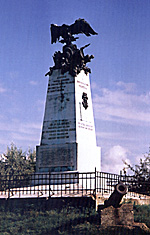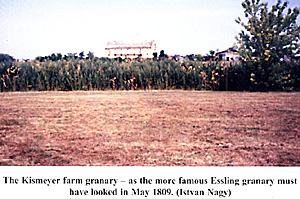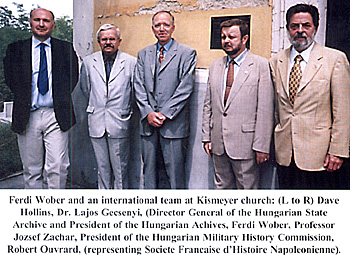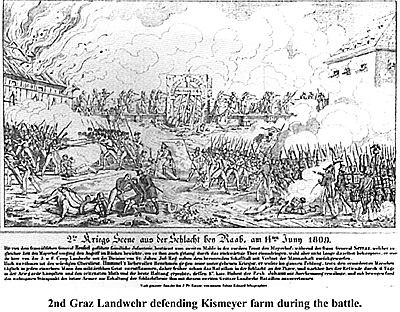A Trip to Raab 2001
Battlefield Visit
by Dave Hollins, UK
| |
The battlefield monument - the Franco-Italian army is briefly mentioned on the left side!
However, not far from here is the scene of the third and least known major battle fought by French forces on 14th June: Raab as it was known then was contested in 1809 - exactly 9 years after Marengo and 2 after Friedland -between the Franco-Italian Army under Prince Eugene Beauharnais and the Austrian Army under Archduke John, as Eugene marched out of Italy to join Napoleon.
This year, the 192nd anniversary was marked with the launch of Ferdi Woberís new book: Schlacht bei Raab 1809, and a group outing from Vienna to meet up with
various Hungarians who have helped Ferdi out in his research, a mix of Gyor locals and Museum staff from Budapest. The anniversary coincided with a religious
holiday in Austria, which seemed to be an excuse for half of Vienna to set off for the border and Hungarian supermarkets. Somehow the train seemed a better idea, but
the delay at the frontier wasnít too bad and we were soon in Gyor, enjoying some local specialities, while Ferdi Wober met with the local mayor and press, ably assisted by his local translator, Anita Szephegyi. I suppose Magyar canít be that difficult as small children have mastered it, but I admire anyone who can manage Magyar, (unlike most Habsburgs), German and reasonable English! Our coach driver was not to be outdone - Hungarian sideroads are not great and often lined with ditches, but he nimbly swerved between cars and a truck awkwardly parked down a small road in Kismeyer village to a round of applause from the passengers.
Wober himself has previously written Schlacht bei Aspern und Essling, which has sold successfully and gone through several editions in German since 1996 as well as proving a useful reference for Ian Castle when he wrote the Osprey Campaign on Aspern & Wagram 1809. Raab was even more complex project, involving not only documents in Magyar but also in Latin (then still Hungaryís governmental language). The battle itself was a defence by Archduke John of a position running east from the fortress city of Raab along the Pandsza river with a mix of regular troops who had fought in Italy, and Hungarian Insurrection (militia). Based either side of the village of Kismeyer, they faced a frontal assault by Eugeneís infantry across the marshy stream and outflanking move by Grouchy round their more open left. The first feature of much of Hungary, which strikes you, is just how flat it is and so, any rise in the ground especially at a junction of several rivers, will be of strategic importance. The whole area is very reminiscent of the 1809 battlefields on the Marchfeld near Vienna.
Stopping at the church, on which Ferdi has arranged for a commemorative plaque to be added, it is obvious why the Austrian army was directed from here, as there is a clear view across much of the battlefield and especially the ground over which the French approached despite more recent building. It is only a short walk to the Kismeyer farm and its towering Granary, which is very similar to the Essling granary. It has lost the outer wall, which made it like a small fort and the defensive centre of Johnís position in the battle when it was defended by 2nd Graz Landwehr. Another older plaque records the demise of Major Hummel while defending the farm - in the best return since Lazarus, Hummel returned to Graz in July 1809 with news of the post-Wagram armistice.
Across its front runs the Pandsza, still a significant obstacle with muddy banks, albeit much more regulated these days (similar to the Russbach at Wagram)
and beyond a huge memorial to the battle, much larger than those commemorating the battles near Vienna. It was a year to the day since the Marengo bicentennial and it seemed rather more pleasant to be in the sunshine with Romain Baulesch, commander of the Allied forces at the soggy quagmire, which was the Italian
reenactment.
Raab is surprisingly significant to the Hungarians, as it is the only battle where they were essentially engaged on their own (most of Johnís regulars were Hungarian
units) against a western European army, rather than assorted Turks and Slavs or rebelling against the Austrians. Ferdiís research has also shown that it was not, as
John later claimed, a defeat brought about by the flight of Insurrection cavalry guarding he open left, but in fact, these troops fought very well and it was case of
numbers telling in the end. There has consequently been quite a lot of local interest and the last stage of the visit was a live interview for Ferdi at the local Gyor TV station. Hidden away in what appeared to be the local youth centre, it didnít come as a great surprise to find the technical staff seemed to be about the right age to use the facilities.
As in TV stations the world over, the studio scenery was about as steady as the sets in soaps like Crossroads, although it came up better on camera. Under the lights, it was already getting hot as Anita tackled her first TV translation. A somewhat crazy trip followed with four of us (three of us being less than thin) and a large framed photograph in Anitaís Trabant, symbol of Eastern European car production, back to the railway station. A surprise turn of speed ensured we were in good time to meet the Budapest train.
The Hungarian capital held something of a new experience - my previous visits on rather dank winter days contrasted with a blazing hot day and plenty of tourists this time. After a quick beer or two (the tourists get charged almost London prices!), a visit to the Army Museum included its excellent current special exhibition on the Symbols of Hungary. Inevitably, this focused on the development of the light cavalry and its equipment, following on from the arrival of the Magyars in the 12th century. I had seen the 18th century standards before (courtesy of a visit to the storerooms a couple of years ago with the curator) but they are stunning out on display along with that most effective piece of kit, a Panzerstecher with its 1.5m blade for skewering Turks through their chain mail. Money of course is a problem, but the exhibits throughout the Museum are laid out most imaginatively, especially the recreation of a mountain bunker from the First World War.
No trip to Budapest is complete without a steam clean, so the last call was to the Rudas (pronounce that how you wish!) Baths, an old Turkish bathhouse for men only. This was my third trip, but I have yet to summon the courage for anything more elaborate than the basic steam - all the signs are in Magyar, so I have no idea what I would be letting myself in for anyway. They must have known I was coming: the third (and hottest room) was officially 70 degrees, but had worked itself up to 85! A Japanese (probably an escapee from Endurance or one of their other masochistic TV game shows) was obviously intent on disappearing in a stream of sweat - I had to acknowledge defeat in this Anglo-Japanese contest and headed off for the cool central pool. Never mind, the local beer is not great, but tastes fantastic after being boiled alive - and I could kid myself I had shed a few pounds.
Back to Vienna to hear that the all-conquering internal combustion engine is to win another victory over the French Emperor. It is bad enough that the General
Motors factory sits right between Aspern and Essling along the line of the ditch, which formed the basis of the French centre in May 1809. Now, a motorway ringroad is to be built to the north of Vienna and is expected to be open by 2006. Like the M25 round London, it will mark the new outer edge of the city, which will run close to the famous villages of Deutsch Wagram, Baumersdorf and Markgrafneusiedl, effectively concreting over the Wagram battlefield. So, go and see it before it is too late - Aspern has already largely gone. The film of that battle would have to be made in Gyor - it seems appropriate that I must translate Ferdiís two books together now (for the late Autumn hopefully).
|
 To anyone who has travelled by train in central Europe, Gyor is probably just another rather dismal railway junction between Vienna and Budapest. For reasons best known to themselves, the Hungarians have decided to paint it almost completely with a job lot of rather vile green emulsion, reminiscent of the shades beloved on TV house makeover programmes.
To anyone who has travelled by train in central Europe, Gyor is probably just another rather dismal railway junction between Vienna and Budapest. For reasons best known to themselves, the Hungarians have decided to paint it almost completely with a job lot of rather vile green emulsion, reminiscent of the shades beloved on TV house makeover programmes.
 The Kismeyer farm granary - as the more famous Essling granary must have looked in May 1809. (Istvan Nagy)
The Kismeyer farm granary - as the more famous Essling granary must have looked in May 1809. (Istvan Nagy)
 Ferdi Wober and an international team at Kismeyer church: (L to R) Dave Hollins, Dr. Lajos Gecsenyi, (Director General of the Hungarian State Archive and President of the Hungarian Achives, Ferdi Wober, Professor Jozsef Zachar, President of the Hungarian Military History Commission, Robert Ouvrard, (representing Societe Francaise díHistoire Napoleonienne)
Ferdi Wober and an international team at Kismeyer church: (L to R) Dave Hollins, Dr. Lajos Gecsenyi, (Director General of the Hungarian State Archive and President of the Hungarian Achives, Ferdi Wober, Professor Jozsef Zachar, President of the Hungarian Military History Commission, Robert Ouvrard, (representing Societe Francaise díHistoire Napoleonienne)
 2nd Graz Landwehr defending Kismeyer farm during the battle.
2nd Graz Landwehr defending Kismeyer farm during the battle.